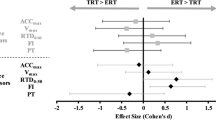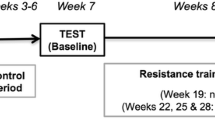Abstract
Purpose
The purpose of this study was to determine the effect of age on the cross-education of rapid and maximal contractile properties for the knee extensors.
Methods
Young (n = 10; age = 21.1 ± 1.7 years) and older (n = 10; age = 65.3 ± 8.3 years) males performed unilateral isokinetic resistance training (RT) of the knee extensors for 4 weeks. Maximal voluntary isokinetic (45° s−1 and 300° s−1) and isometric testing was conducted for the trained and untrained leg before and after RT. Peak torque (PT) and acceleration were obtained from isokinetic testing as well as torque at 30 ms (TQ30) and 100 ms (TQ100) from the 45° s−1 contraction. PT and rate of torque development were recorded from the isometric contractions.
Results
Independent of age, isometric PT (10.1%; p = 0.006) as well as PT and acceleration at 300° s−1 (6.7%; p = 0.008 and 4.0%; p = 0.016, respectively) increased in the untrained leg. At 45° s−1, acceleration was increased (3.6%; p = 0.021), but PT remained unchanged (p = 0.227). TQ100 increased similarly between groups (4.5%; p = 0.014), but TQ30 increased only in the older group (9.5%; p = 0.022).
Conclusions
Cross-education of rapid and maximal contractile parameters can be achieved early during unilateral RT independent of age. These findings indicate the potential for particular unilateral RT protocols to be used for older adults in rehabilitative settings to offset disuse-related reductions in contractile function, which are most dramatic in this population.





Similar content being viewed by others
Abbreviations
- ACC45 :
-
Acceleration at 45° s−1
- ACC300 :
-
Acceleration at 300° s−1
- CV:
-
Coefficient of variation
- ICC:
-
Intraclass correlation coefficient
- MVIC:
-
Maximal voluntary isometric contraction
- OM:
-
Older males
- PT45 :
-
Peak torque at 45° s−1
- PT300 :
-
Peak torque at 300° s−1
- RFD:
-
Rate of force development
- RT:
-
Resistance training
- RTD:
-
Rate of torque development
- SEM:
-
Standard error of the measurement
- TQ30 :
-
Torque at 30 ms
- TQ100 :
-
Torque at 100 ms
- YM:
-
Young males
References
Aagaard P, Simonsen E, Trolle M, Bangsbo J, Klausen K (1996) Specificity of training velocity and training load on gains in isokinetic knee joint strength. Acta Physiol 156:123–129
Adamson M, MacQuaide N, Helgerud J, Hoff J, Kemi OJ (2008) Unilateral arm strength training improves contralateral peak force and rate of force development. Eur J Appl Physiol 103:553–559
Altubasi IM (2015) Is quadriceps muscle strength a determinant of the physical function of the elderly? J Phys Ther Sci 27:3035–3038
Barry BK, Warman GE, Carson RG (2005) Age-related differences in rapid muscle activation after rate of force development training of the elbow flexors. Exp Brain Res 162:122–132
Bemben M, Murphy R (2001) Age related neural adaptation following short term resistance training in women. J Sports Med Phys Fit 41:291
Bryanton M, Bilodeau M (2017) The role of thigh muscular efforts in limiting sit-to-stand capacity in healthy young and older adults. Aging Clin Exp Res 29:1211–1219
Cannon J, Kay D, Tarpenning KM, Marino FE (2007) Comparative effects of resistance training on peak isometric torque, muscle hypertrophy, voluntary activation and surface EMG between young and elderly women. Clin Physiol Funct Imaging 27:91–100
Christie A, Kamen G (2010) Short-term training adaptations in maximal motor unit firing rates and after hyperpolarization duration. Muscle Nerve 41:651–660
Clémençon M, Hautier CA, Rahmani A, Cornu C, Bonnefoy M (2008) Potential role of optimal velocity as a qualitative factor of physical functional performance in women aged 72 to 96 years. Arch Phys Med Rehabil 89:1594–1599
Collins BW, Lockyer EJ, Button DC (2017) Prescribing cross education of strength: is it time? Muscle Nerve 56:684–685
Coyle EF, Feiring D, Rotkis T, Cote R III, Roby F, Lee W, Wilmore J (1981) Specificity of power improvements through slow and fast isokinetic training. J Appl Physiol 51:1437–1442
Deschenes MR, Holdren AN, Mccoy RW (2008) Adaptations to short-term muscle unloading in young and aged men. Med Sci Sports Exerc 40:856–863
Devine KL, LeVeau BF, Yack HJ (1981) Electromyographic activity recorded from an unexercised muscle during maximal isometric exercise of the contralateral agonists and antagonists. Phys Ther 61:898–903
Ehsani F, Nodehi-Moghadam A, Ghandali H, Ahmadizade Z (2014) The comparison of cross-education effect in young and elderly females from unilateral training of the elbow flexors. Med J Islam Repub Iran 28:138
Englund DA, Sharp RL, Selsby JT, Ganesan SS, Franke WD (2017) Resistance training performed at distinct angular velocities elicits velocity-specific alterations in muscle strength and mobility status in older adults. Exp Gerontol 91:51–56
Farthing JP, Chilibeck PD (2003) The effect of eccentric training at different velocities on cross-education. Eur J Appl Physiol 89:570–577
Farthing JP, Zehr EP (2014) Restoring symmetry: clinical applications of cross-education. Exerc Sport Sci Rev 42:70–75
Fimland MS, Helgerud J, Solstad GM, Iversen VM, Leivseth G, Hoff J (2009) Neural adaptations underlying cross-education after unilateral strength training. Eur J Appl Physiol 107:723–730
Gerstner GR, Thompson BJ, Rosenberg JG, Sobolewski EJ, Scharville MJ, Ryan ED (2017) Neural and muscular contributions to the age-related reductions in rapid strength. Med Sci Sports Exerc 49:1331–1339
Hester GM et al (2019) Age does not attenuate maximal velocity adaptations in the ipsilateral and contralateral limbs during unilateral resistance training. J Aging Phys Act 27:1–8
Hortobágyi T, Lambert NJ, Hill JP (1997) Greater cross education following training with muscle lengthening than shortening. Med Sci Sports Exerc 29:107–112
Hughes MA, Myers BS, Schenkman ML (1996) The role of strength in rising from a chair in the functionally impaired elderly. J Biomech 29:1509–1513
Hvid L et al (2010) Effects of aging on muscle mechanical function and muscle fiber morphology during short-term immobilization and subsequent retraining. J Appl Physiol 109:1628–1634
Kamen G, Knight CA (2004) Training-related adaptations in motor unit discharge rate in young and older adults. J Gerontol A Biol Sci Med Sci 59:1334–1338
Kanehisa H, Miyashita M (1983) Specificity of velocity in strength training. Eur J Appl Physiol Occup Physiol 52:104–106
Kim C-Y, Lee J-S, Kim H-D, Kim J-S (2015) The effect of progressive task-oriented training on a supplementary tilt table on lower extremity muscle strength and gait recovery in patients with hemiplegic stroke. Gait Posture 41:425–430
Klass M, Baudry S, Duchateau J (2008) Age-related decline in rate of torque development is accompanied by lower maximal motor unit discharge frequency during fast contractions. J Appl Physiol 104:739–746
Knight C, Kamen G (2001) Adaptations in muscular activation of the knee extensor muscles with strength training in young and older adults. J Electromyogr Kinesiol 11:405–412
Kozicka I, Kostka T (2016) Handgrip strength, quadriceps muscle power, and optimal shortening velocity roles in maintaining functional abilities in older adults living in a long-term care home: a 1-year follow-up study. Clin Interv Aging 11:739
Lee M, Carroll TJ (2007) Cross education. Sports Med 37:1–14
Lee M, Gandevia SC, Carroll TJ (2009) Unilateral strength training increases voluntary activation of the opposite untrained limb. Clin Neurophysiol 120:802–808
Lemmer JT et al (2000) Age and gender responses to strength training and detraining. Med Sci Sports Exerc 32:1505–1512
Lum PS, Patten C, Kothari D, Yap R (2004) Effects of velocity on maximal torque production in poststroke hemiparesis. Muscle Nerve 30:732–742
Magnus CR, Arnold CM, Johnston G, Haas VD-B, Basran J, Krentz JR, Farthing JP (2013) Cross-education for improving strength and mobility after distal radius fractures: a randomized controlled trial. Arch Phys Med Rehabil 94:1247–1255
Osawa Y, Studenski SA, Ferrucci L (2018) Knee extension rate of torque development and peak torque: associations with lower extremity function. J Cachexia Sarcopenia Muscle 9:530–539
Petrella JK, Kim J-s, Tuggle SC, Hall SR, Bamman MM (2005) Age differences in knee extension power, contractile velocity, and fatigability. J Appl Physiol 98:211–220
Ploutz LL, Tesch PA, Biro RL, Dudley GA (1994) Effect of resistance training on muscle use during exercise. J Appl Physiol 76:1675–1681
Seger JY, Arvidsson B, Thorstensson A, Seger JY (1998) Specific effects of eccentric and concentric training on muscle strength and morphology in humans. Eur J Appl Physiol Occup Physiol 79:49–57
Shrout PE, Fleiss JL (1979) Intraclass correlations: uses in assessing rater reliability. Psychol Bull 86:420
Thompson BJ, Ryan ED, Sobolewski EJ, Conchola EC, Cramer JT (2013) Age related differences in maximal and rapid torque characteristics of the leg extensors and flexors in young, middle-aged and old men. Exp Gerontol 48:277–282
Thompson BJ, Conchola EC, Palmer TB, Stock MS (2014) Effects of aging on maximal and rapid velocity capacities of the leg extensors. Exp Gerontol 58:128–131
Tillin NA, Folland JP (2014) Maximal and explosive strength training elicit distinct neuromuscular adaptations, specific to the training stimulus. Eur J Appl Physiol 114:365–374
Tillin NA, Pain MT, Folland JP (2012) Short-term training for explosive strength causes neural and mechanical adaptations. Exp Physiol 97:630–641
Tøien T, Unhjem R, Øren TS, Kvellestad ACG, Hoff J, Wang E (2018) Neural plasticity with age: Unilateral maximal strength training augments efferent neural drive to the contralateral limb in older adults. J Gerontol Ser A 73:596–602
Tracy B et al (1999) Muscle quality. II. Effects of strength training in 65- to 75-year-old men and women. J Appl Physiol 86:195–201
Weir JP (2005) Quantifying test-retest reliability using the intraclass correlation coefficient and the SEM. J Strength Cond Res 19:231–240
Acknowledgements
We would like to thank Mr. Pope for his assistance with some aspects of the data collection.
Funding
This research did not receive any specific grant from funding agencies in the public, commercial, or not-for-profit sectors.
Author information
Authors and Affiliations
Contributions
GH and JD conceived and designed the research. GH, MM, RC, AB-C, CE collected the data. AO, AB, PH processed the data and assisted with analysis. GH conducted statistical analysis and prepared the manuscript. JD reviewed and revised the manuscript. All authors read and approved the final version.
Corresponding author
Additional information
Communicated by William J. Kraemer.
Publisher’s Note
Springer Nature remains neutral with regard to jurisdictional claims in published maps and institutional affiliations.
Rights and permissions
About this article
Cite this article
Hester, G.M., Magrini, M.A., Colquhoun, R.J. et al. Cross-education: effects of age on rapid and maximal voluntary contractile characteristics in males. Eur J Appl Physiol 119, 1313–1322 (2019). https://doi.org/10.1007/s00421-019-04123-8
Received:
Accepted:
Published:
Issue Date:
DOI: https://doi.org/10.1007/s00421-019-04123-8




